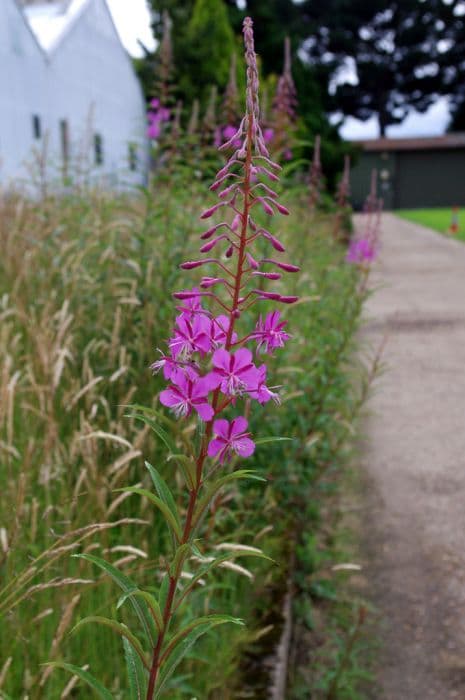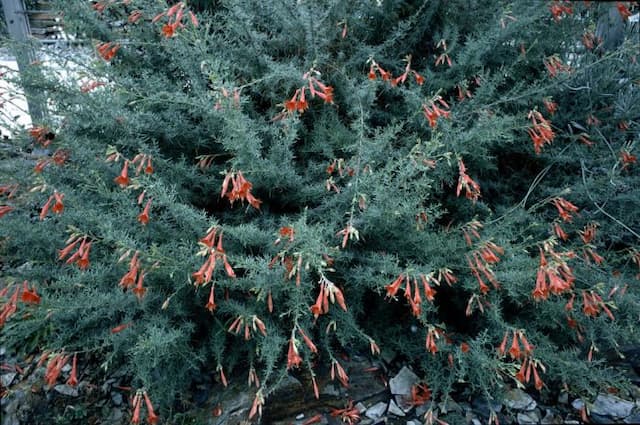Gaura Oenothera lindheimeri Rosyjane = 'Harrosy' (PBR) (G)
![gaura [Rosyjane]](/_next/image?url=https%3A%2F%2Fplants-admin.emdemapps.com%2Fimages%2Fplants%2F%2Fimages%2F604b60b2d76d9.png&w=3840&q=75)
ABOUT
The plant known commonly as Rosyjane has a striking yet delicate appearance characterized by its beautiful flowers and foliage. The flowers of Rosyjane are truly distinctive; each blossom features a unique two-tone pattern. The petals typically display a white base, transitioning to a soft pink hue towards the tips, which resembles a brush stroke effect. This gradient of color creates a pleasant contrast that can easily draw the gaze of any onlooker. Rosyjane's blooms are not only notable for their coloration but also for their shape. They have a classic, open form with a cup or saucer shape that allows pollinators easy access. The petals are slightly ruffled at the edges, giving them a gentle, inviting look. The foliage of this plant further complements the blooms. The leaves are narrow and elongated, with a texture that can be described as somewhat lance-like. They form a dense tuft or mound, offering a lush green backdrop that makes the pink and white flowers stand out even more prominently. Overall, Rosyjane presents a soft yet lively appearance, with its combination of unique two-toned flowers and the graceful greenery of its leaves. It’s a plant that can add a touch of elegance to any garden or floral display.
About this plant
 Names
NamesSynonyms
Gaura 'Rosy Jane', Lindheimer's Beeblossom 'Rosy Jane', White Gaura with a pink picotee, Wand Flower 'Rosy Jane'.
Common names
Gaura lindheimeri, Gaura lindheimeri 'Rosy Jane', Oenothera lindheimeri.
 Toxicity
ToxicityTo humans
Oenothera lindheimeri, commonly known as Gaura, is not known to be toxic to humans. Therefore, ingestion of this plant is not expected to cause poisoning or adverse health effects.
To pets
Gaura is also not known to be toxic to pets. It is generally considered safe and should not cause poisoning or adverse health consequences if pets ingest parts of this plant. However, as with any non-food plant, ingestion in large quantities could potentially cause mild stomach upset simply due to being an unfamiliar material in the digestive system.
 Characteristics
CharacteristicsLife cycle
Perennials
Foliage type
Deciduous
Color of leaves
Green
Flower color
Mixed
Height
2-3 feet (60-90 cm)
Spread
2-3 feet (60-90 cm)
Plant type
Herb
Hardiness zones
5
Native area
North America
Benefits
 General Benefits
General Benefits- Attracts Pollinators: Rosyjane (Oenothera lindheimeri 'Harrosy') invites beneficial insects, such as bees and butterflies, to the garden, enhancing pollination of plants.
- Drought Tolerant: Once established, Rosyjane is known for its ability to withstand periods of dryness, making it suitable for water-wise gardens.
- Low Maintenance: This variety generally requires minimal care, reducing the need for frequent watering, pruning, or fertilization.
- Long Blooming: Rosyjane has a lengthy flowering period, often from early summer to fall, providing extended visual interest in the landscape.
- Aesthetic Appeal: Its unique pink and white bicolored blossoms and attractive form add aesthetic value to gardens and landscapes.
- Wildlife Friendly: The plant supports local ecosystems by providing habitat and food resources for wildlife like insects and birds.
- Adaptable: Rosyjane can thrive in a range of soil types and environmental conditions, making it a versatile addition to various garden styles.
- Erosion Control: With its fibrous root system, it helps prevent soil erosion, proving useful in sloped areas of a garden or landscape.
 Medical Properties
Medical PropertiesThis plant is not used for medical purposes.
 Air-purifying Qualities
Air-purifying QualitiesThis plant is not specifically known for air purifying qualities.
 Other Uses
Other Uses- Creating natural dyes: The petals of the Gaura can be used to produce subtle natural dyes for fabrics and yarns.
- Photography and art subjects: With its delicate flowers, Gaura is a popular choice for photographers and artists looking to capture the beauty of nature.
- Educational purposes: Gaura is often used in educational settings to teach botany and the life cycle of perennial plants.
- Decorative dried flowers: The stems and flowers of Gaura can be dried and used in floral arrangements and crafts.
- Crafting eco-friendly confetti: The dried petals of Gaura can be used as a biodegradable confetti alternative for celebrations.
- Bee and butterfly gardens: Gaura is an excellent plant for creating gardens specifically designed to attract and support pollinators.
- Landscape photography: Gaura, with its natural grace and long blooming season, adds a whimsical touch to landscape photography.
- Garden borders: Gaura can be used as a border plant in gardens, providing a light, airy edge to garden beds.
- Companion planting: When used in companion planting, Gaura can provide benefits for nearby plants by attracting beneficial insects.
- Culinary garnish: Although not a common use, the flowers of Gaura can be used as an edible garnish for their delicate appearance, but ensure they are safe and pesticide-free before consumption.
Interesting Facts
 Feng Shui
Feng ShuiThe plant Gaura is not used in Feng Shui practice.
 Zodiac Sign Compitability
Zodiac Sign CompitabilityThe plant Gaura is not used in astrology practice.
 Plant Symbolism
Plant Symbolism- Hope and Optimism: Oenothera lindheimeri, commonly known as Gaura, often symbolizes hope and optimism. The plant's resilience and ability to adapt to difficult environments can serve as a metaphor for overcoming challenges.
- Peace and Serenity: Gaura's delicate white or pink flowers have a gentle appearance which can evoke feelings of peace and serenity.
 Water
WaterGaura, commonly known as Whirling Butterflies, should be watered regularly, especially during its first growing season, to establish a deep, extensive root system. Once established, they are quite drought tolerant. During hot summer months, water the plant once a week with approximately 1 gallon, ensuring the soil is moistened but not waterlogged. Gaura may require more frequent watering if conditions are extremely hot or dry but always allow the soil to dry out slightly between watering sessions.
 Light
LightGaura thrives best in full sun conditions, receiving at least 6 to 8 hours of direct sunlight daily. Place the plant in an area where it can enjoy unfiltered sunlight for most of the day. The plant can tolerate partial shade, but flowering may be reduced in less than full sun locations.
 Temperature
TemperatureGaura is hardy and can tolerate a temperature range from approximately 50°F to 90°F. It can survive brief periods of colder temperatures down to about 10°F but is best suited to areas where the temperature does not drop below freezing for long periods. The ideal temperature for gaura to thrive is between 60°F and 70°F.
 Pruning
PruningPrune gaura, or Whirling Butterflies, to promote bushier growth and more blooms. Cut back the plant by one-third in late winter or early spring before new growth begins; this is the best time for pruning. Deadheading spent flowers throughout the season can also encourage more blooms. Gaura can be cut back again lightly in late summer if it becomes leggy.
 Cleaning
CleaningAs needed
 Soil
SoilGaura, the most common name for Oenothera lindheimeri, prefers well-draining soil with a pH between 5.5 to 7. The ideal soil mix should consist of loamy or sandy soil amended with organic matter such as compost or well-rotted manure, enhancing drainage and fertility.
 Repotting
RepottingGauras do not require frequent repotting and should be repotted only when they have outgrown their current container or every 2 to 3 years to refresh the soil.
 Humidity & Misting
Humidity & MistingGauras thrive in average humidity conditions, typical of outdoor environments. They do not have specific humidity requirements but appreciate good air circulation around the foliage.
 Suitable locations
Suitable locationsIndoor
Place Gaura near a sunny window, water when dry.
Outdoor
Plant Gaura in full sun, well-drained soil.
Hardiness zone
5-9 USDA
 Life cycle
Life cycleOenothera lindheimeri 'Rosyjane', commonly known as Gaura or Whirling Butterflies, has a perennial life cycle. The life cycle begins with seed germination which typically occurs in spring when temperatures warm. Following germination, seedlings establish themselves and develop into rosettes, with a deep taproot and foliage at the base. Throughout the growing season, the plant will rapidly grow upward and outward, producing tall, slender stems with alternating leaves and blooming with distinctive pink and white bi-colored flowers from late spring into fall. These flowers are pollinated by insects, leading to the development of small seed capsules that release seeds upon maturation. The plant then enters dormancy during winter, with the foliage often dying back, only to resprout from the root system when favorable conditions return in spring.
 Propogation
PropogationPropogation time
Spring - Summer
Oenothera lindheimeri 'Rosyjane', commonly known as Gaura 'Rosyjane', is typically propagated by softwood cuttings in late spring or early summer when the plant is actively growing. To propagate by cuttings, select a healthy, non-flowering stem and cut a 3- to 5-inch (approximately 7.5 to 12.5 cm) piece, making sure at least two nodes are included. Remove the lower leaves, and dip the base of the cutting into rooting hormone powder to enhance root development. Insert the cutting into a pot filled with a well-draining soil mix, ensuring at least one node is below the soil surface. Keep the cutting moist and in a warm place with indirect light until roots develop, which usually takes several weeks. Once rooted, the cuttings can be transplanted into individual pots or directly into the garden.









